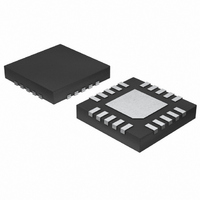MAX17006BETP+ Maxim Integrated Products, MAX17006BETP+ Datasheet - Page 16

MAX17006BETP+
Manufacturer Part Number
MAX17006BETP+
Description
IC BATT CHARGER 1.2MHZ 20-TQFN
Manufacturer
Maxim Integrated Products
Specifications of MAX17006BETP+
Function
Charge Management
Battery Type
Multi-Chemistry
Voltage - Supply
8 V ~ 26 V
Operating Temperature
-40°C ~ 85°C
Mounting Type
Surface Mount
Package / Case
20-TQFN Exposed Pad
Lead Free Status / RoHS Status
Lead free / RoHS Compliant
1.2MHz, Low-Cost,
High-Performance Chargers
The MAX17005B/MAX17006B/MAX17015B control
input current (CCS control loop), charge current (CCI
control loop), or charge voltage (CC control loop),
depending on the operating condition. The three con-
trol loops, CC, CCI, and CCS are brought together
internally at the lowest voltage clamp (LVC) amplifier.
The output of the LVC amplifier is the feedback control
signal for the DC-DC controller. The minimum voltage
at the CC, CCI, or CCS appears at the output of the
LVC amplifier and clamps the other control loops to
within 0.3V above the control point. Clamping the other
two control loops close to the lowest control loop
ensures fast transition with minimal overshoot when
switching between different control loops (see the
Compensation section). The CCS and CCI loops are
compensated internally, and the CC loop is compen-
sated externally.
With sufficiently large charge current, the MAX17005B/
MAX17006B/MAX17015Bs’ inductor current never
crosses zero, which is defined as continuous-conduc-
tion mode. The controller starts a new cycle by turning
on the high-side MOSFET and turning off the low-side
MOSFET. When the charge-current feedback signal
(CSI) is greater than the control point (LVC), the CCMP
comparator output goes high and the controller initiates
the off-time by turning off the high-side MOSFET and
turning on the low-side MOSFET. The operating fre-
quency is governed by the off-time and is dependent
upon V
The on-time can be determined using the following
equation:
where:
The switching frequency can then be calculated:
16
______________________________________________________________________________________
CC, CCI, CCS, and LVC Control Blocks
CSIN
and V
I
RIPPLE
Continuous-Conduction Mode
t
DCIN
ON
f
SW
=
.
=
=
V
DCIN
L I
t
V
ON
CSIN
×
RIPPLE
+
1
-
L
V
t
×
OFF
CSIN
t
OFF
At the end of the computed off-time, the controller initi-
ates a new cycle if the control point (LVC) is greater
than 10mV (V
current is less than the cycle-by-cycle current limit.
Restated another way, IMIN must be high, IMAX must
be low, and OVP must be low for the controller to initi-
ate a new cycle. If the peak inductor current exceeds
IMAX comparator threshold or the output voltage
exceeds the OVP threshold, then the on-time is termi-
nated. The cycle-by-cycle current limit effectively pro-
tects against overcurrent and short-circuit faults.
If during the off-time the inductor current goes to zero,
the ZCMP comparator output pulls high, turning off the
low-side MOSFET. Both the high- and low-side
MOSFETs are turned off until another cycle is ready to
begin. ZCOMP causes the MAX17005B/MAX17006B/
MAX17015B to enter into the discontinuous conduction
mode (see the Discontinuous Conduction section).
The MAX17005B/MAX17006B/MAX17015B can also
operate in discontinuous conduction mode to ensure that
the inductor current is always positive. The MAX17005B/
MAX17006B/MAX17015B enter discontinuous conduction
mode when the output of the LVC control point falls below
10mV (referred at V
corresponds to a peak inductor current of 1A.
In discontinuous mode, a new cycle is not started until
the LVC voltage rises above IMIN. Discontinuous mode
operation can occur during conditioning charge of
overdischarged battery packs, when the charge cur-
rent has been reduced sufficiently by the CCS control
loop, or when the charger is in constant-voltage mode
with a nearly full battery pack.
The charge voltage, charge current, and input current-
limit regulation loops are compensated separately. The
charge current and input current-limit loops, CCI and
CCS, are compensated internally, whereas the charge
voltage loop is compensated externally at CC.
For CC compensation, connect a 0.01µF capacitor at
CC. The crossover frequency occurs at:
where:
GMV = 0.125µA/mV
GM
OUT
= 5A/V
f
CO CV
_
CSIP
=
GM
CSIP
- V
Discontinuous Conduction
OUT
CSIN
- V
×
CSIN
referred), and the charge
G
MV
). For RS2 = 10mΩ, this
×
2
π
Compensation
1 7
×
.
C
k
Ω
OUT











